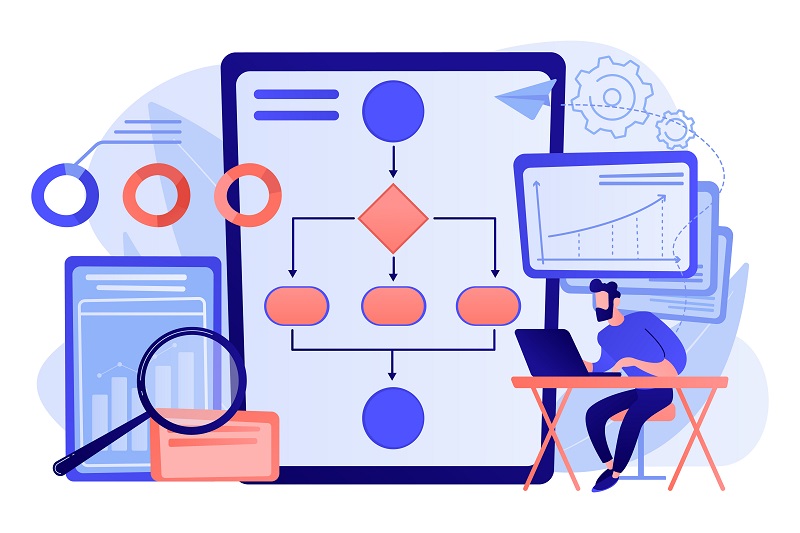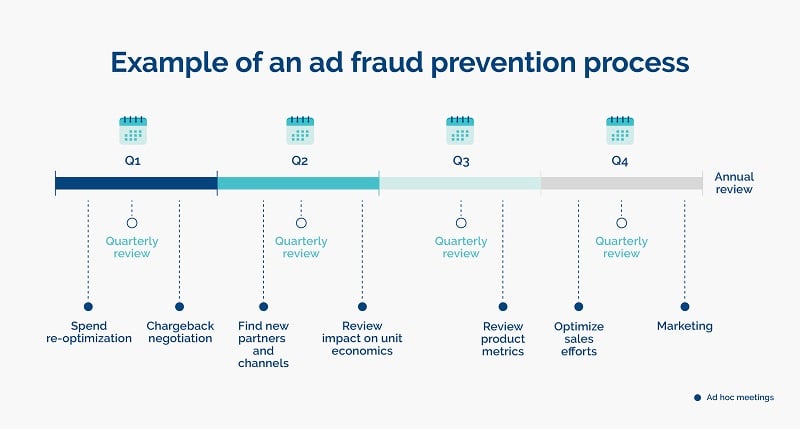How to Set Up a Fraud Prevention Process

 By
Eduardo Aznar
·
3 minute read
By
Eduardo Aznar
·
3 minute read
Despite the fact that digital ads are the core of their marketing strategies, ad fraud is often an afterthought in the minds of digital advertisers. Rather than proactively seeking to prevent ad fraud from damaging their campaigns, it’s often only once their campaigns are targeted that they seek to detect and block further ad fraud attacks.
Advertisers lose billions of dollars every year to ad fraud. It’s a high price to pay -- one that’s expected to amount to losses of $100 billion by 2023. So, why is ad fraud prevention not yet a core focus for any business that relies on digital ad campaigns?
In this article, we explore the importance of a fraud prevention process and how establishing one can not only keep fraud at bay, but can help organizations achieve their acquisition, growth, and revenue targets.
What is a fraud prevention process?
A fraud prevention process places the prevention of ad fraud at the core of a business and its growth strategy. It’s a combination of resources (both people and systems), timings, and agendas that enable a company to ensure that ad fraud is kept at bay and that any impacts from ad fraud are minimal.
The idea behind a comprehensive fraud prevention process is to align siloed systems, departments, and individuals so that they can better focus on preventing ad fraud as a whole. Often, anti-fraud activities fall to many different individuals and systems, and thus accountability and responsibility for these activities (and their resulting performance) is unclear.
Fraud prevention should be thought of as a business function and should be at the center of any growth strategy, aiming to bring all key stakeholders and systems from the company together to achieve this goal.
Why is a fraud prevention process critical for organizations?
Advertisers are frustrated with the impact ad fraud has on their campaigns, budgets, and analytics. Although they may not immediately attribute it to ad fraud (or at all!), they will feel the negative effects that ad fraud techniques have on their objectives. Plus, up until very recently, no comprehensive technology was available to help detect and block ad fraud when it occurred.
Despite the rise in anti-ad fraud technology, tackling ad fraud has not traditionally been a priority for advertisers or their organizations as a whole. However, centering fraud prevention in your corporate strategy has many benefits. Let’s take a look at a few below:
Prevents budgetary losses
All types of ad fraud have the potential to drain ad budgets rapidly. Whether it’s clickjacking, where organizations are charged for clicks that never convert, or pixel stuffing, where advertisers are charged for fake impressions, putting fraud prevention at front and center helps limit financial losses caused by fraudsters.
Allows for true analytics
Campaigns affected by ad fraud also produce distorted data. Often, ad fraud tricks advertisers into thinking their campaigns are ineffective or overachieving, leading them to base future campaign and/or organizational decisions on flawed data. Preventing fraud from the outset helps advertisers make only the best decisions that will help them hit their targets and objectives.
Helps organizations achieve their acquisition, growth, and revenue objectives
When organizations are constantly on the back foot fighting the effects of ad fraud, they’re not focused on their business objectives. Whether they’re focused on reducing their Customer Acquisition Costs (CAC), improving their Return on Ad Spend (ROAS), are in a critical growth phase, or are simply trying to boost revenue, a solid fraud prevention process will help them focus on their objectives.
What should a typical fraud prevention process look like?
Fraud prevention processes will look different for every organization, each with its own unique business objectives, company structure, budgets, and systems.
However, fraud prevention is a process that needs to be managed in order to empower your organization to have continued and robust fraud prevention. Here are just a few functions that should form part of any fraud prevention process:
- Spend re-optimization: This entails understanding which channels are working and reassessing the weight given to them.
- Review of campaign data: Campaign data should be at the forefront of any fraud prevention process, backed by a fraud prevention committee to help steer the function’s direction.
- Finding new partners and channels: When certain channels or partners aren’t working (i.e., they are attracting fraudulent clicks or leads), it’s time to look for legitimate sources elsewhere.
- Review of fraud’s impact on unit economics: This is usually led by an organization’s CFO or another Finance lead.
- Optimization of sales efforts: This is usually led by an organization’s CSO (Chief Sales Officer).
How often an organization makes changes depends on many factors. However, quarterly reviews should be held to accommodate for any fluctuations in campaign/organizational performance, while major changes can be made annually.
 An example of what a typical annual fraud prevention calendar could look like.
An example of what a typical annual fraud prevention calendar could look like.
Bolster the success of your organization with a fraud prevention process
As ad fraud gains more and more traction, you need to be in the hot seat of driving prevention methods to safeguard your organization.
With fraud prevention built into your company strategy, you’ll be well-placed to save money and resources and achieve your business goals.
To find out how Opticks can form part of your fraud prevention process, contact us here.
